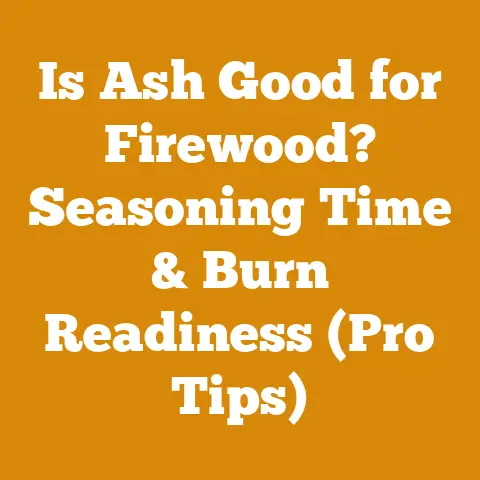Install Wood Burning Stove in Basement (5 Expert Tips for Flue Setup)
One of the most crucial aspects of a successful wood-burning stove installation, especially in a basement, is getting the flue setup absolutely right.
My expert tip?
Don’t skimp on the flue!
Over the years, I’ve seen countless installations fail due to undersized or improperly installed flues, leading to smoky rooms, inefficient burning, and even dangerous carbon monoxide buildup.
Think of the flue as the engine’s exhaust system – if it can’t breathe properly, the whole thing suffers.
Installing a Wood Burning Stove in a Basement: 5 Expert Tips for Flue Setup
Basement installations of wood-burning stoves present unique challenges.
Unlike a stove placed on a ground floor with a direct vertical flue run, basements often require navigating around joists, beams, and other obstacles.
The flue, therefore, becomes even more critical for ensuring proper draft and safe operation.
I’m going to walk you through five essential tips to help you get it right.
1. Understanding the Importance of Proper Draft
Draft is the engine that drives your wood stove.
It’s the natural upward flow of air through the stove and flue, pulling in oxygen for combustion and carrying away smoke and gases.
Without sufficient draft, your stove will struggle to burn efficiently, producing more smoke, creosote, and potentially dangerous carbon monoxide.
- The Stack Effect: Draft is created by the difference in temperature between the hot flue gases and the cooler air outside.
The taller the flue, the stronger the draft.
This is why basement installations can be tricky – you need to ensure the flue is tall enough to overcome the cooler temperatures and longer horizontal runs. - My Experience: I once worked on a basement installation where the homeowner tried to save money by using a short, single-wall flue pipe.
The result was a smoky mess every time he tried to light a fire.
We ended up extending the flue with a proper insulated chimney system to achieve the necessary draft.
The difference was night and day. - Data Point: As a general rule, I tell people that a flue should extend at least 3 feet above the highest point of the roof that it passes through and be at least 15 feet in total height, measured from the stove outlet.
2. Choosing the Right Flue Pipe and Chimney System
Selecting the correct flue pipe and chimney system is paramount for safety and efficiency.
You can’t just use any old pipe!
- Flue Pipe: This connects the stove to the chimney.
For stoves, I always recommend using black, single-wall or double-wall stove pipe that meets UL 103HT standards.
Double-wall pipe radiates less heat into the room, which is beneficial in tight basement spaces and reduces clearances to combustibles.- Single-Wall: Typically 24-gauge steel.
Cheaper but radiates more heat.
Requires greater clearance from combustible materials. - Double-Wall: Safer and more efficient.
Reduces clearances to combustibles.
More expensive initially, but a better long-term investment.
- Single-Wall: Typically 24-gauge steel.
- Chimney System: This is the vertical structure that carries the exhaust gases outside.
For wood stoves, you’ll need a Class A insulated chimney system.
These are designed to withstand the high temperatures and corrosive nature of wood-burning exhaust.- Class A Chimneys: These have multiple layers of insulation and are tested to withstand temperatures up to 2100°F.
They are essential for safety and performance. - My Insight: Don’t try to save money by using a B-vent chimney, which is designed for gas appliances.
It won’t withstand the high temperatures of a wood stove and could lead to a house fire.
- Class A Chimneys: These have multiple layers of insulation and are tested to withstand temperatures up to 2100°F.
- Technical Requirement: All flue pipes and chimney systems must be listed and labeled to meet UL 103HT standards in the US or ULC S629 in Canada.
This ensures they have been tested and certified for use with wood-burning appliances.
3. Maintaining Proper Clearances to Combustibles
One of the biggest safety concerns with wood stove installations is maintaining adequate clearances to combustible materials.
This means keeping the stove and flue pipe far enough away from walls, ceilings, and other flammable items.
- Why it Matters: Wood stoves generate a lot of heat, and even a seemingly small gap can be enough to ignite nearby combustibles.
- Clearance Requirements: Clearances vary depending on the type of stove, flue pipe, and wall protection used.
Always consult the stove manufacturer’s instructions and local building codes for specific requirements.- Typical Clearances: For single-wall flue pipe, clearances can range from 18 to 36 inches from combustible walls.
Double-wall pipe and wall shields can significantly reduce these clearances. - Example: A stove with a listed clearance of 36 inches to combustibles can have that clearance reduced by up to 66% with the proper wall protection.
- Typical Clearances: For single-wall flue pipe, clearances can range from 18 to 36 inches from combustible walls.
- Wall Protection: If you can’t meet the minimum clearance requirements, you’ll need to install wall protection.
This can include:- Non-combustible materials: Brick, stone, or metal sheeting.
- Spacers: Create an air gap between the wall and the protective material to further reduce heat transfer.
- Case Study: I once inspected a home where the homeowner had installed a wood stove without proper clearances.
The flue pipe was only a few inches from a wooden wall.
Fortunately, I caught it before a fire started.
We installed a metal heat shield with an air gap, which significantly reduced the wall temperature. - Data Point: According to the National Fire Protection Association (NFPA), heating equipment is a leading cause of home fires, and improper installation is a major contributing factor.
4. Ensuring a Proper Flue Height and Termination
The height and termination of your flue are critical for proper draft and preventing smoke from re-entering your home.
- Height Requirements: As I mentioned earlier, the flue should extend at least 3 feet above the highest point of the roof that it passes through and be at least 15 feet in total height, measured from the stove outlet.
- Why it Matters: The 3-foot rule helps prevent downdrafts caused by wind flowing over the roof.
The 15-foot minimum ensures sufficient draft. - Termination: The top of the flue should be equipped with a chimney cap to prevent rain, snow, and debris from entering.
- Spark Arrestor: In some areas, a spark arrestor is required to prevent sparks from escaping the flue and potentially starting a fire.
- Wind Direction: Consider the prevailing wind direction when positioning the flue.
Avoid placing it in a location where wind is likely to blow directly into the opening.
- My Experience: I had a situation where a customer complained about smoke backing up into their home on windy days.
It turned out that their flue was located on the leeward side of the house, creating a negative pressure zone that pulled smoke back down.
We installed a taller flue with a special wind-directional cap, which solved the problem.
5. Sealing and Inspecting the Flue System
A properly sealed flue system is essential for preventing leaks of smoke and dangerous gases into your home.
Regular inspections are crucial for maintaining its integrity and safety.
- Sealing: All connections between flue pipes and chimney sections should be tightly sealed with high-temperature sealant.
- Best Practices: Use a sealant specifically designed for wood stoves and chimneys.
Apply it liberally to all joints and seams. - Visual Inspection: After installation, carefully inspect the entire flue system for any gaps or cracks.
- Best Practices: Use a sealant specifically designed for wood stoves and chimneys.
- Inspection: Inspect your flue system at least once a year, preferably before the start of the heating season.
- What to Look For: Check for creosote buildup, cracks, corrosion, and any signs of damage.
- Professional Inspection: Consider hiring a certified chimney sweep to perform a professional inspection.
They have the tools and expertise to identify potential problems that you might miss.
- Creosote Buildup: Creosote is a highly flammable substance that accumulates in the flue as a byproduct of wood burning.
Excessive creosote buildup can lead to a chimney fire.- Data Point: According to the Chimney Safety Institute of America (CSIA), chimney fires are a leading cause of home fires, and creosote buildup is a major contributing factor.
- Prevention: Burn seasoned wood, maintain a hot fire, and have your chimney cleaned regularly to prevent creosote buildup.
I aim to clean my chimney every 1-2 cords of wood burned.
- Legal Requirement: Many jurisdictions legally require annual chimney inspections and cleaning to ensure safety and compliance with fire codes.
Additional Considerations for Basement Installations
Beyond the flue, there are several other factors to consider when installing a wood-burning stove in a basement.
1. Ventilation
Basements are often poorly ventilated, which can lead to a buildup of smoke and carbon monoxide if the stove isn’t burning properly.
- Carbon Monoxide Detectors: Install carbon monoxide detectors on every level of your home, especially near sleeping areas.
- Fresh Air Intake: Consider installing a fresh air intake near the stove to provide a source of oxygen for combustion and help prevent negative pressure in the basement.
2. Floor Protection
Wood stoves can radiate a lot of heat downwards, so it’s important to protect the floor with a non-combustible hearth pad.
- Hearth Pad Requirements: The hearth pad should extend at least 16 inches in front of the stove and 8 inches to the sides.
- Material Options: Brick, stone, tile, and concrete are all suitable materials for a hearth pad.
3. Wood Storage
Storing wood in your basement can introduce moisture and pests.
- Best Practices: Store only a small amount of wood near the stove for immediate use.
Keep the bulk of your wood supply outside, covered and elevated off the ground. - Wood Moisture Content: Aim for a wood moisture content of 20% or less for efficient burning.
Use a moisture meter to check the moisture content of your wood.
Wood Selection Criteria: Fueling Your Stove Efficiently
The type of wood you burn significantly impacts the stove’s efficiency, heat output, and creosote buildup.
Hardwoods vs. Softwoods: Understanding the Differences
- Hardwoods: Denser woods like oak, maple, and ash burn longer and produce more heat.
They are ideal for sustained burning.- Oak: Known for its high heat output and long burn time.
A popular choice for wood stoves. - Maple: Burns cleanly and produces a good amount of heat.
- Ash: Easy to split and burns well, even when slightly green.
- Oak: Known for its high heat output and long burn time.
- Softwoods: Woods like pine, fir, and spruce burn faster and produce more smoke and creosote.
They are best used for starting fires or short bursts of heat.- Pine: Burns quickly and produces a lot of heat, but also generates more creosote.
- Fir: Similar to pine in terms of burning characteristics.
- Spruce: Burns relatively cleanly compared to other softwoods.
Seasoning Wood: The Key to Efficient Burning
Seasoning wood involves drying it to reduce its moisture content.
- Why it Matters: Green wood contains a high amount of moisture, which reduces its heat output and increases smoke and creosote production.
- Drying Process: Split the wood and stack it in a sunny, well-ventilated area for at least six months, preferably a year.
- Moisture Content: Aim for a moisture content of 20% or less.
Use a moisture meter to check the moisture content of your wood.- Data Point: Wood with a moisture content of 20% or less can produce up to twice as much heat as green wood.
Log Dimensions and Cord Volumes: Measurements for Success
Understanding log dimensions and cord volumes is essential for efficient wood processing and storage.
- Log Diameter: The ideal log diameter for firewood depends on the size of your stove.
Generally, logs with a diameter of 6-8 inches are a good size for most stoves. - Log Length: Cut logs to a length that fits easily into your stove.
Typically, 16-inch logs are a good choice. - Cord Volumes: A standard cord of wood is a stack that measures 4 feet high, 4 feet wide, and 8 feet long, for a total volume of 128 cubic feet.
- Face Cord: A face cord (also known as a rick or stove cord) is a stack that measures 4 feet high and 8 feet long, but the width varies depending on the length of the logs.
Tool Calibration Standards: Ensuring Optimal Performance
Maintaining your tools in top condition is crucial for safe and efficient wood processing.
Chainsaw Calibration: Precision Cutting for Productivity
- Chain Sharpness: A sharp chain is essential for efficient cutting.
Sharpen your chain regularly using a file or a chain grinder. - Chain Tension: Maintain proper chain tension to prevent the chain from derailing or binding.
The chain should be snug but still able to be pulled around the bar by hand. - Bar Lubrication: Ensure that the bar oiler is working properly to lubricate the chain and bar.
- Carburetor Adjustment: Adjust the carburetor to ensure that the engine is running smoothly and efficiently.
- Technical Requirement: Chainsaw carburetors should be adjusted according to the manufacturer’s specifications.
Use a tachometer to measure the engine speed and adjust the high and low speed needles accordingly.
- Technical Requirement: Chainsaw carburetors should be adjusted according to the manufacturer’s specifications.
Splitting Axe Maintenance: Power and Precision
- Sharpness: Keep your splitting axe sharp to make splitting easier and safer.
- Handle Condition: Inspect the handle regularly for cracks or damage.
Replace the handle if necessary. - Head Security: Ensure that the axe head is securely attached to the handle.
Safety Equipment Requirements: Protecting Yourself
Safety should always be your top priority when working with wood.
Essential Gear: Head-to-Toe Protection
- Eye Protection: Wear safety glasses or a face shield to protect your eyes from flying debris.
- Hearing Protection: Wear earplugs or earmuffs to protect your hearing from the noise of the chainsaw and other equipment.
- Hand Protection: Wear gloves to protect your hands from cuts, splinters, and vibration.
- Leg Protection: Wear chainsaw chaps or pants to protect your legs from chainsaw cuts.
- Foot Protection: Wear steel-toed boots to protect your feet from falling logs and other hazards.
- Head Protection: Wear a helmet to protect your head from falling branches and other overhead hazards.
First Aid Kit: Be Prepared for Emergencies
- Contents: Keep a well-stocked first aid kit on hand in case of accidents.
Include items such as bandages, antiseptic wipes, pain relievers, and a tourniquet. - Training: Take a first aid and CPR course to learn how to respond to emergencies.
Conclusion: Enjoying the Warmth Safely
Installing a wood-burning stove in your basement can provide a cozy and efficient source of heat.
By following these expert tips and prioritizing safety, you can enjoy the warmth of a wood-burning fire without compromising your well-being.
Remember to consult local building codes and regulations before starting any installation project.
Happy burning!






